Features of aquarium nail extension
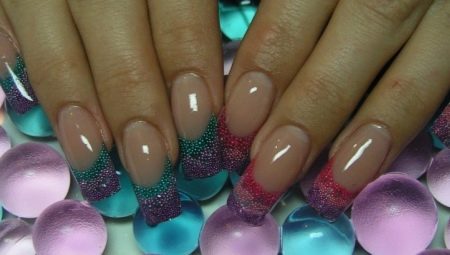
Aquarium building is a fairly popular trend in nail design. Such marigolds always look festive, original and unbeatable. What are the features of a manicure "aquarium", what are the positive and negative sides of such a design, let's consider.
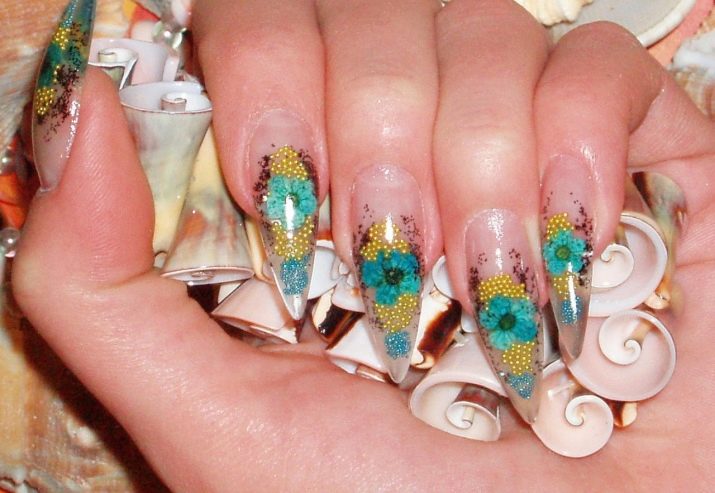
Advantages and disadvantages
Aquarium extension is a way to lengthen nails, in which various decorative elements are placed in the layers of the gel. As a result of such a manicure, a design is formed on the nails, closed under the thickness of the "glass".
This way of designing fingers has a number of advantages.
- Manicure "aquarium" is quite durable. It can be worn for three months. The only thing that will need to be done is to slightly correct the edge of the cuticle, file the regrown shape and finish drawing.
- All decorative elements are located in the thickness of the design, so they do not rub during wear, and also do not cling to clothing.
- The presence of such a manicure does not require additional decorations on the fingers, the nails themselves will accentuate your hands.
- Suitable for both long and short nails.
- This way of building up allows the master to create a unique design with three-dimensional images.
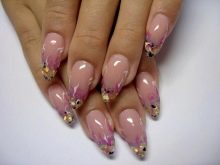
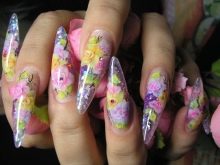
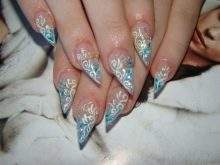
But the aquarium build-up has minor drawbacks.
- The technique of this manicure is rather complicated, so it is better to trust it to professionals.
- "Aquarium" is always quite bright, so it is not suitable for a business style. You will need to cover it with calm monochromatic varnishes.
- This kind of nail art is quite expensive in contrast to the surface design.
- In some cases, the nails are thick.
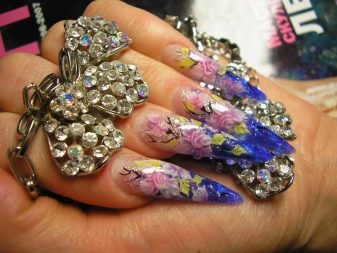
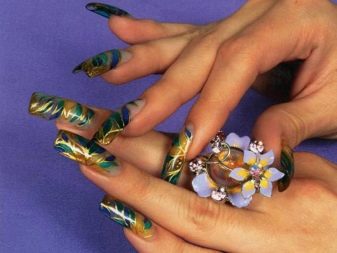
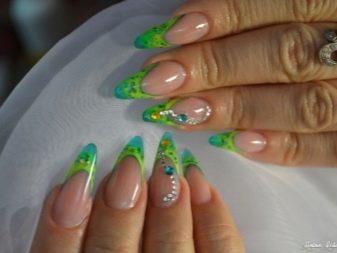
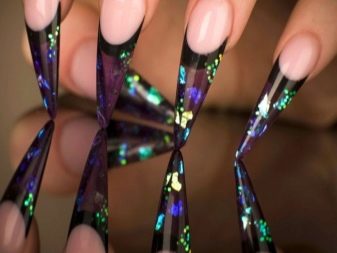
Application method
If you have already mastered the technique of gel nail extension, you can try to create an "aquarium" on your nails yourself.
To do this, you will need the following materials and tools:
- files with abrasiveness of 180 and 250 grit;
- pusher and orange sticks;
- flat brush with synthetic hair;
- degreaser;
- primer;
- gels - transparent, camouflage and colored, if your design implies them;
- decorative elements - everything that you want to put into the thickness of the nail, for example, it can be rhinestones, sparkles, dried flowers, acrylic pastes and much more.
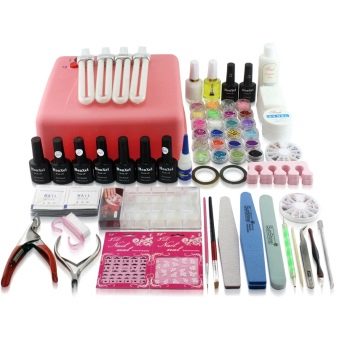
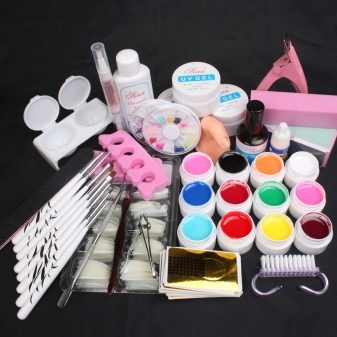
Finishing coat
Having collected everything you need, you first need to prepare your nails for extension. To do this, push the cuticle aside with a pusher, clean the pterygium well, cut off the excess skin and go over the plate with a file, removing the top layer.
Next, we sweep the dust from the nails with a dry brush, treat them with a degreaser. Here you need to use a special tool. But if it is absent, you can replace the degreaser with alcohol or vinegar.
In the next step, a primer is applied. This composition does not require drying in a lamp, it is intended to make the surface of the nail plate rough for a stronger adhesion of the gel and the nail.
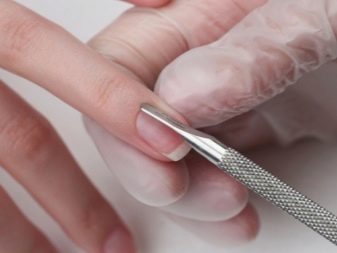
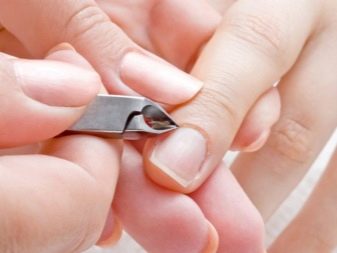
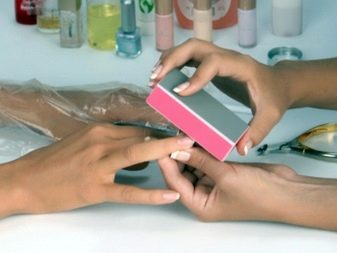
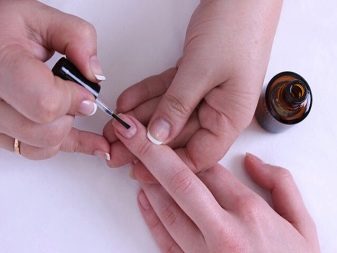
Now you need to install the form for building. To do this, we put the tapered part under the edge of the nail plate, carefully fix it. We check whether the form has settled evenly, whether there are gaps between it and the nail plate, if necessary, we slightly cut the workpiece with scissors.
Apply a thin layer of transparent gel to the surface of the nail, moving to the shape. We form the required length. Let the composition level out for a few seconds. Dry in a lamp.
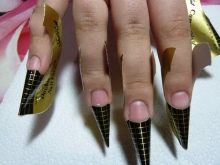
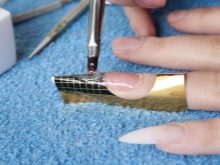
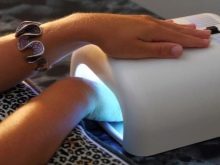
We take camouflage gel. We put a drop on the nail plate, position the gel so as to simulate the skin under the nail. The layer of gel should come to naught to the cuticle and lateral ridges, then, when the nail plate grows, the transition will be hardly noticeable. Dry again in the lamp.
Place the first design layer on the free edge and cover it with transparent gel. At this stage, volumetric elements are usually used, since the layer here will be the thickest, and also lay the tone. We dry it. Now you can remove the form.
Laying down the next layer of the design. Here you can use glitter, sequins and other not very voluminous elements. Cover it again with a layer of transparent gel and dry it in a lamp.
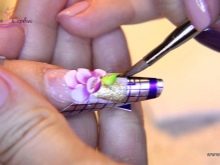
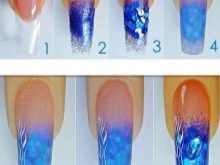
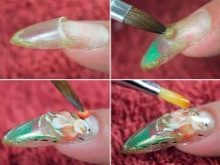
There can be several such layers, the main thing is that the result is a not too thick nail, otherwise the work will look sloppy.
We make sawdust work. We remove the top layer of the gel from the plate itself, and also give it the required shape.
We cover the nails with a finishing layer of liquid UV gel, not forgetting to walk along the edge of the nail. If your extended nails turned out to be rather long, then it is recommended to cover them with such a gel from the inside as well. This layer will not only provide protection to your manicure and give shine to the coating, but also reduce the harmful effects of ultraviolet rays on the nails.
At the last stage, we will treat the cuticle with a special oil, since, being dried in a lamp, it has lost a lot of moisture and may crack.
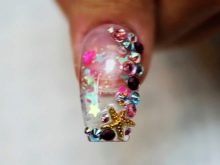
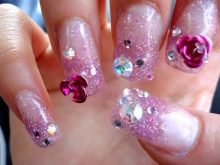

Beautiful examples
Aquarium nail extension always looks gorgeous and elegant. Performing this nail design, the master can embody any fantasy. The highest level of skill here is the use of elements of acrylic modeling. Of course, such elements give an increased thickness of the finished nail, but your manicure will definitely attract attention.
Here are some pretty interesting examples of how you can design nails using the aquarium technique.
Sea
The ocean floor with its various inhabitants, shiny sand in a pastel blue tone looks expensive, but by no means clumsy.
The nautical theme can be decorated with kamifubuki.And to make it clear at first glance that this is the sea, it is worth adding a small starfish to the "water column".
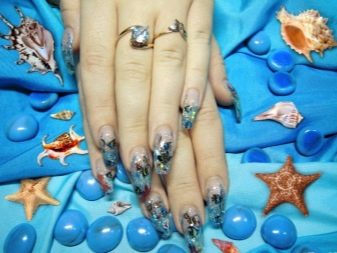
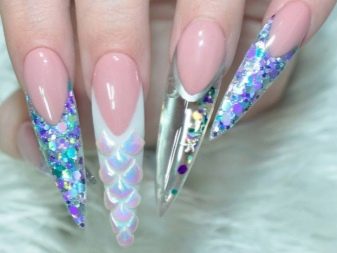
Flowers
The floral design always gives a feminine touch to the image, especially if the decor elements are made in pastel colors.
Aquarium manicure is an excellent solution for wedding design as well.

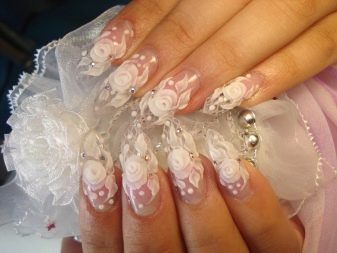
French
French manicure in classic colors can also be decorated using the aquarium technique.
And also a jacket can be bright and shiny for a spring mood or passionate in black and red for "Lady Vamp".
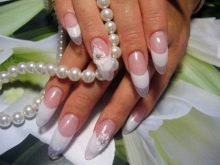
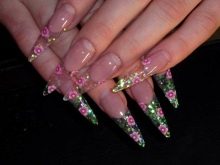
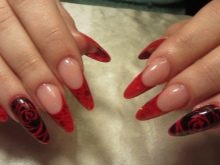
Other decor
You can also decorate the "aquarium" with a clockwork. Such marigolds will attract the attention of even the stronger sex.
Aquarium manicure can be decorated not only in the thickness of the gelbut also decorated with elements on the outside. The main thing is not to overdo it. Usually, no more than two fingers on the hand are decorated in this way.
The manicure itself is quite simple and does not contain a large amount of decorative elements, while the ring fingers are decorated with rather voluminous rhinestones over the extension.
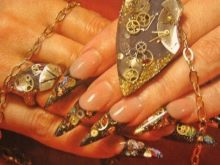
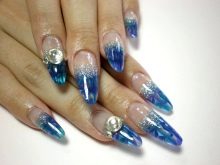
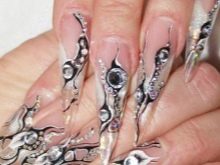
Outer rhinestones can be on all fingers, then the design inside the "aquarium" should not contain sparkles at all, and the colors in the manicure should be used, for example, in black and white.
How to build up an aquarium jacket, see the next video.








